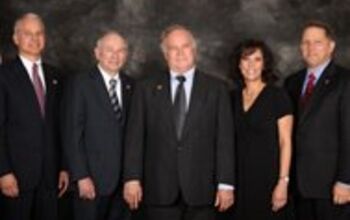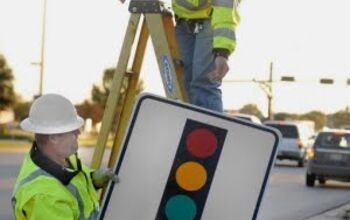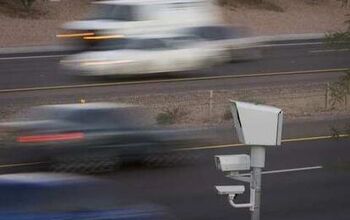More California Cities Keep, Dump Red Light Cameras
Three California city councils debated whether to keep or discard red light cameras last week. In Loma Linda officials on Tuesday voted to drop automated enforcement while South San Francisco officials voted to keep it on Wednesday. The debates followed in the wake of a decision by the city of San Carlos last Monday to drop cameras after the duration of the yellow light at the camera-enforced intersection was extended by one second, eliminating the system’s profitability.
San Carlos Mayor Randy Royce wrote to the South San Francisco council urging them not to renew their automated ticketing contract with American Traffic Solutions (ATS).
“Our city council is disappointed with the representations made by Redflex and our approved motion included direction to staff to go back to the vendor and propose termination of the three-year contract immediately,” Royce wrote. “My personal recommendations as learned from this experience are that 1) don’t assume that red light cameras improve safety, 2) recognize that people are generally smarter than cameras so expect a significant reduction in citations over time, and 3) never commit to a lease term longer than your cell-phone provider.”
The South San Francisco council ignored the advice and approved a long-term contract extension. Vice Mayor Kevin Mullin argued that although the city’s cameras have not been in operation long enough to judge their effectiveness, he trusted the results of other cities that claimed accidents were reduced after camera installation. About a dozen ordinary citizens showed up to disagree while three testified in favor of keeping the devices. The most common complaint centered around the seemingly random flashing from the camera.
“The lights are very bright and on a few occasions when I was turning right, the light was so bright my vision was impaired for a couple of seconds,” motorist Diane Fitzgibbon said. “I wonder if the police department considers this safe. As you know it only takes a few seconds for an accident to occur.”
Despite being discouraged from doing so by the mayor, the audience applauded residents who opposed cameras. More than one resident suggested this is a matter better decided by the people.
“I’d love to see American Traffic Solutions’ business plan,” motorist Jim Lawless told the city council. “Going around the country and getting places to put in things saying, ‘no installation cost, no startup fees, turnkey operation.’ They’re selling it to you. But the one thing they haven’t done in terms of environmental impact — you got an approval from CalTrans according to this report — but you didn’t get the approval of the citizens of South San Francisco…. You people stop voting on this and let us vote on it, because I don’t think the people of South San Francisco want it.”
Although the city began issuing tickets in August 2009, most citations have been refunded due to legal problems with the council’s action. According to police data, 95 percent of citations went to people who made slow right-hand turns at red lights. Mayor Mark Addiego was convinced that after all of the trouble the program should finally be canceled.
“I’m not OK taking this much money out of the economy at this time,” Addiego said. “These initial five months, $1.5 million — $300,000 a month. That’s great revenue, but it’s like ill-gotten gains. Someone spoke this evening about the populace, the citizenry, losing respect for the police. I’m afraid that’s happening to a degree. There’s a lot of passion in this, and I don’t want that directed at my police department. It’s not worth it.”
In the end, however, only Councilman Pedro Gonzalez supported Addiego in seeking to terminate the contract. The council voted 3-2 for an extension and the program will resume ticketing on May 15.
In Loma Linda, the council agreed that there was a consensus in the community to drop red light camera ticketing. The city will send a letter to Redflex Traffic Systems of Australia “at the earliest time” informing them that the city will not renew its contract in December. Loma Linda saw a 92 percent drop in violations after it lengthened the duration of yellow lights by one second.
[Courtesy: TheNewspaper.com]
More by The Newspaper
Latest Car Reviews
Read moreLatest Product Reviews
Read moreRecent Comments
- Jeff JMII--If I did not get my Maverick my next choice was a Santa Cruz. They are different but then they are both compact pickups the only real compact pickups on the market. I am glad to hear that the Santa Cruz will have knobs and buttons on it for 2025 it would be good if they offered a hybrid as well. When I looked at both trucks it was less about brand loyalty and more about price, size, and features. I have owned 2 gm made trucks in the past and liked both but gm does not make a true compact truck and neither does Ram, Toyota, or Nissan. The Maverick was the only Ford product that I wanted. If I wanted a larger truck I would have kept either my 99 S-10 extended cab with a 2.2 I-4 5 speed or my 08 Isuzu I-370 4 x 4 with the 3.7 I-5, tow package, heated leather seats, and other niceties and it road like a luxury vehicle. I believe the demand is there for other manufacturers to make compact pickups. The proposed hybrid Toyota Stout would be a great truck. Subaru has experience making small trucks and they could make a very competitive compact truck and Subaru has a great all wheel drive system. Chevy has a great compact pickup offered in South America called the Montana which gm could be made in North America and offered in the US and Canada. Ram has a great little compact truck offered in South America as well.
- Groza George I don’t care about GM’s anything. They have not had anything of interest or of reasonable quality in a generation and now solely stay on business to provide UAW retirement while they slowly move production to Mexico.
- Arthur Dailey We have a lease coming due in October and no intention of buying the vehicle when the lease is up.Trying to decide on a replacement vehicle our preferences are the Maverick, Subaru Forester and Mazda CX-5 or CX-30.Unfortunately both the Maverick and Subaru are thin on the ground. Would prefer a Maverick with the hybrid, but the wife has 2 'must haves' those being heated seats and blind spot monitoring. That requires a factory order on the Maverick bringing Canadian price in the mid $40k range, and a delivery time of TBD. For the Subaru it looks like we would have to go up 2 trim levels to get those and that also puts it into the mid $40k range.Therefore are contemplating take another 2 or 3 year lease. Hoping that vehicle supply and prices stabilize and purchasing a hybrid or electric when that lease expires. By then we will both be retired, so that vehicle could be a 'forever car'. And an increased 'carbon tax' just kicked in this week in most of Canada. Prices are currently $1.72 per litre. Which according to my rough calculations is approximately $5.00 per gallon in US currency.Any recommendations would be welcomed.
- Eric Wait! They're moving? Mexico??!!
- GrumpyOldMan All modern road vehicles have tachometers in RPM X 1000. I've often wondered if that is a nanny-state regulation to prevent drivers from confusing it with the speedometer. If so, the Ford retro gauges would appear to be illegal.


































Comments
Join the conversation
"Loma Linda saw a 92 percent drop in violations after it lengthened the duration of yellow lights by one second." The above statement is an eye opener. Does anyone know if the red light camera/speed camera detector from Escort works well?